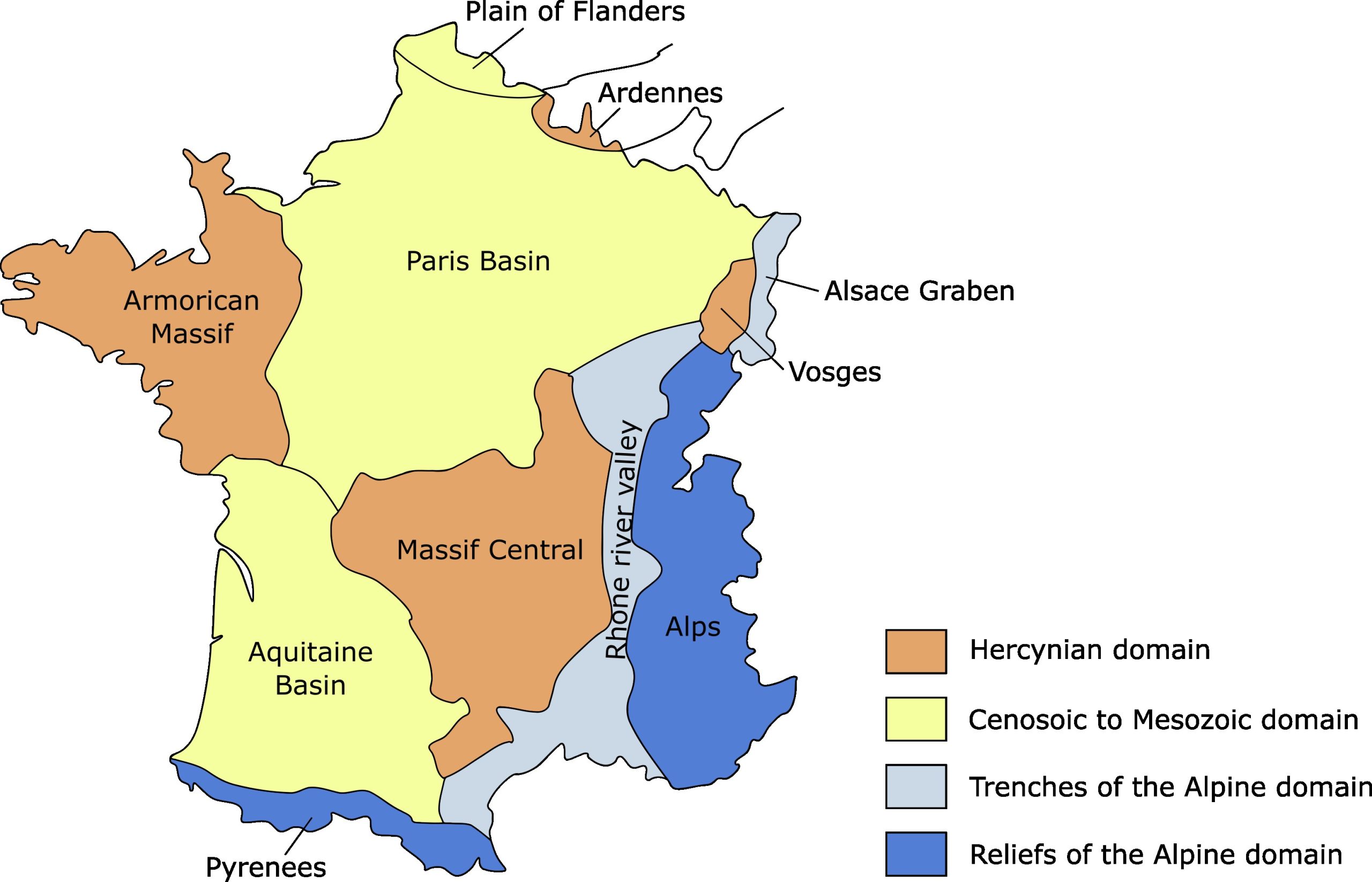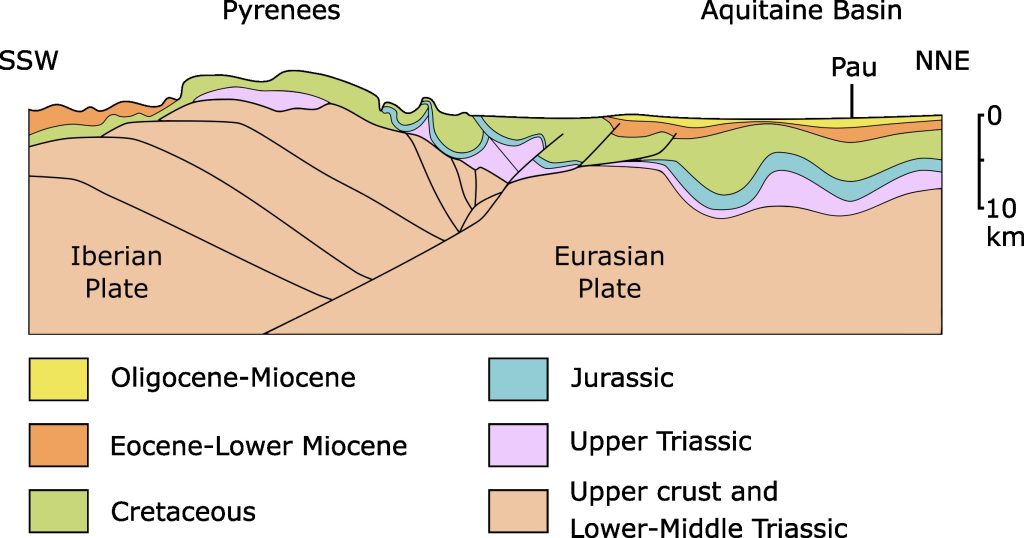The peloton can take a breather today and fuel up in the flat terrain as they cross the Aquitaine Basin. It’s a region full of hidden treasures. You know geoTDF by now. While the professional riders navigate through a giant sandbox, we take a look at what lies beneath their wheels. We have rock formations up to 250 million years old. They house the largest oil reserves on continental France and nearly all of the country’s gas reserves. Additionally, we take a glimpse at a highly coveted technology for underground CO₂ storage. It aims to help mitigate the human-induced climate crisis. Aquitaine is the place where it is set to be implemented. So let’s fuel up for stage 13. Hope everyone is lucky!

Foreland
Where there are mountains, there are valleys, and often also a foreland basin. A foreland basin is a depression that typically forms in front of a mountain range. That’s different than the Paris Basin we saw on stage 10. The mountains exert an unusually high load on a continental plate. This immense load can lead to deformation of the continental plate and the formation of basins in front of a mountain range. We know such basins as foreland basins. They serve as reservoirs for everything that erodes from the mountains.
The Aquitanian Basin first formed in Triassic and Jurassic time, between ~220 and 170 million years ago. It was the time when Pangea broke up. An ocean basin formed between Europe, Iberia, and Africa in the Mediterranean region. Then, when this ocean closed, Iberia hit Europe and formed the Pyrenees. The Aquitaine basin got squeezed together.
The weight of the Pyrenees led to many kilometers of subsidence. This made the Aquitanian basin a foreland basin. Today, you can only recognize the shape of the basin by geological maps or geophysical measurements. This is due to the fact that it was filled with sediments from the surrounding mountains, especially the Pyrenees, over the course of some 60 millions years. The layers of rock that form the bedrock today are evidence of the environmental conditions during their deposition.

Cross-section of the western Pyrenees and the Aquitaine basin. The once horizontal geological layers were compressed and folded when the former Iberian continental plate collided with Eurasia. The flexure of the continental crust created the Aquitaine foreland basin. Adapted per source.
Fuel up
The Aquitaine Basin has been in a life-friendly climate zone since its formation. Life flourished here. Lots of organic material was produced and deposited here in the course of the basin’s development. The organic deposits include, for example, dead plant remains or plankton. It all accumulated in the basin and became covered by sediments over time. Today’s rock layers, which were formed from this organic-rich sediment, are called the source rock of the oil and gas we burn today. Indeed, this organic material formed the basis for the development of hydrocarbon resources (i.e. oil and gas) that we use today for energy production and transportation.

But before we could use these fossil fuels, the deposited organic material had to undergo a lengthy process. Over time, the sediment layer in the basin grew. Its weight created high pressure and warm temperatures in the sediment. This later became the source rock. The hydrocarbons of the deposited organic materials were chemically degraded under these conditions. Ever larger hydrocarbon molecules formed from their components through the processes of polymerization and polycondensation.
The products of these processes decomposed again over time. Et voilà, you have oil and gas. Due to their low density, both oil and gas migrated upwards through the rock pores until they reached an impermeable rock layer. At this boundary, the hydrocarbons accumulated in so-called reservoir rocks. Today, we drill oil and gas wells with drilling rigs to penetrate these reservoir rocks to access and recover these energy sources.
Return to sender
The use of these fossil fuels plays an important role in France’s industry and economy. However, the growing awareness of the climate impact of burning oil and gas is calling into question the future of industrial energy consumption. After all, they are among the biggest CO₂ emitters. One response to the increasing political and social pressure for sustainability is a technology we see in Aquitaine. It should make it possible to extract CO₂ from the air and store it in rock.

The large-scale Pycasso project with more than 200 participants aims to capture some of the CO2 emissions from regional industry in southern France and north-eastern Spain and store them underground. To achieve this, industrial waste gases are to be chemically filtered directly at the point of origin and the CO₂ extracted. Some of the CO₂ will then be used in other industrial sectors such as plant production. The rest will then be stored underground. The idea is to use the existing oil and gas industry infrastructure in Aquitaine for the transportation and storage of the captured CO2. In the first phase of the project, one million tons of CO₂ per year and 5 million tons of CO₂ in the long term are to be returned to where it originally came from. Return to sender, so to speak.
Risks and objections
The IPCC (Intergovernmental Panel on Climate Change) lists carbon capture and storage technology as one of the methods we can use to store excess CO₂ in the long term. However, the effect of the technology is limited. Only a fraction of the CO₂ emitted can be captured. In addition, a great deal of energy is required for carbon capture and storage. The infiltration of fluids into rock layers underground also entails an increase in seismicity. This creates new risks such as gas leaks in pipelines.
In this blog, we want to highlight that the principle of CO₂ storage in rocks and sediments is not at all a human invention. The oil and gas reserves that we use today consist of carbon deposited in the past in the form of biomass. Even today, measures such as peatland restoration and reforestation are still among the most efficient methods of removing CO₂ from the atmosphere. And above all, they do not involve any technical risks. One should thus conclude that carbon capture can make a small contribution to storing CO₂. However, in order to meet the 2-degree target, we need to reduce emissions and take additional measures to bind CO₂ naturally. Take your bike instead of the car sometimes, is already a good start.
NB: Blogs in other languages than English are all auto-translated. Our writers are not responsible for any language and spelling mistakes.






